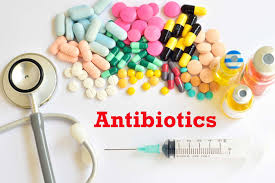
Antibiotics
ANTIBIOTICS
The term antibiotic means against life. ‘‘The chemicals produced by microorganisms that has the ability to inhibit the growth of microorganisms (or destroy them )in small concentrations are called antibiotics” while “Those chemicals that can kill or inhibit the growth of microorganisms are called antimicrobial agents.” The most important groups of antibiotic producing organisms are the bacteria, lower fungi or moulds. Antibiotics belong to very diverse class of chemical compounds. The drugs work against bacteria, fungi and other microbes that damage human tissues. They are selective toxic, that is, they are harmful to pathogenic or disease causing microbes but do not normally damage human cells. Paul Ehrlich ("The Father of Chemotherapy") first suggested the concept of using chemicals (toxins) to target infectious micro-organisms without harming the patient, i.e. selective toxicity. Ehrlich developed ‘Salvarsan’ an arsenic-based compound, is not an antibiotic but it is an antibacterial chemotherapeutic agent which is selectively toxic for the syphilis spirochaete, Treponema pallidum. Salvarsan was much less toxic than the mercury salts previously used to treat syphilis and which probably contributed to the death of King Charles II. William Roberts first described the effect of the mould, Penicillium, on the growth of bacteria in 1874 but he is not credited with discovering antibiotics. In 1928 - Fleming described the effect of a substance produced by Penicillium notatum on staphylococci and researched its possible use as a treatment for bacterial infections.
Sources of Antibiotics:
Antibiotics come from four sources:
1. Bacteria - most prolific source is the Streptomycete group e.g. streptomycin, tetracycline, gentamicin, bacitracin, chloramphenicol, erythromycin, kanamycin, rifamycin.
2. Moulds (filamentous fungi) e.g. penicillins from Penicillium spp., cephalosporins from Cephalosporium spp.
3. Synthesis e.g. chloramphenicol
4. Semi-synthesis. Part of molecule is produced by a microorganism but part of it is modified/altered chemically, usually to improve it. e.g. many penicillins - ampicillin, methicillin (now called meticillin), carbenicillin, cloxacillin etc.
Target sites of Antibiotics:
There are 5 target sites for antibiotics in the bacterial cell:
1. Cell wall synthesis 2. Protein synthesis
3. Nucleic acid synthesis 4. Cell membrane permeability
5.Folate synthesis
Types of Antibiotics
Bactericidal Antibiotics:
Antibiotics that kill bacteria are called "bactericidal". Penicillins, Ampicillin, Streptomycine, Kanamycine,Cefoxitin, Cefotaxime, Cefobid, Quinolone, Metroindazole, Isoniazid, Rifampin etc.
Bacteriostatic Antibiotics:
Antibiotics that stop the growth of bacteria are called "bacteriostatic". Tetracycline, Erythromycine, Linomycine, Trimethoprim, Sulfonamide, Clindamycin and chloramphenicol etc
Qualities of an Antibiotics:
It should be/show:
•Non-toxic •Non-allergenic •Stable •Cheap •No development of resistance to it by bacteria •Have a broad spectrum of activity •Have a long shelf life •Have a nice taste •Variable excretion rate from body (high rate for acute infections and UTIs, low rate for chronic infections) •A high therapeutic index*
*Therapeutic index: The ratio of the dose or concentration required to produce toxic or lethal effects to the dose or concentration required to produce a non-adverse or therapeutic response.
The higher the therapeutic index the better, e.g. penicillins have high ones and are non-toxic even at relatively high levels. An antibiotic that has a low therapeutic index may require the patient's blood level to be monitored to ensure it does not rise to toxic or lethal levels, e.g. administration of gentamicin where level in patient's blood must not exceed 10 µg per ml.


